Contents
Goat mushrooms, or dry butterflies, are found almost everywhere in coniferous forests of the temperate climatic zone. It happens that inexperienced mushroom pickers confuse them with other edible mushrooms (common butter mushrooms, boletus mushrooms or mossiness mushrooms), or even they are completely afraid to put them in a basket, because they don’t know anything about them. In fact, fears about goats are groundless: they are completely edible and do not have false poisonous counterparts. The taste of dry butter is perhaps less expressive than that of their famous ordinary “brothers”, however, if you choose a good recipe and cook them correctly, the result will undoubtedly please fans of mushroom dishes.
What do goat mushrooms look like
To understand what goat mushrooms are, a photo will help:
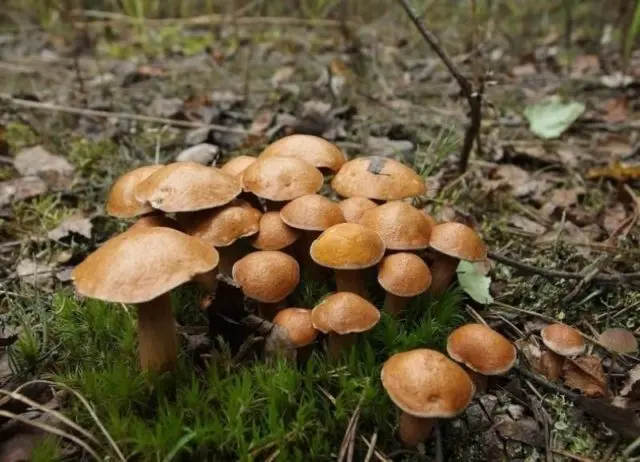
Dry oiler – tubular fungus. His hat is smooth, slightly flattened, yellow-brown, reddish-ocher or light beige in color. In young mushrooms, its edge is white, soft and slightly bent upwards. The size of the cap is average, the diameter is from 3 to 9 cm. During the rainy season, its surface is slippery, slimy and slightly sticky, but if the humidity is not increased, it is dull and dry.
The pores on the underside of the cap are yellow, olive brown or greyish in color and look like small honeycombs. Spores are usually brown or brown.
The legs of the kids are pale yellow, beige or brown. They are hollow, slightly curved, cylindrical. Their length varies from 3 to 11 cm.
What they look like, where they meet and what distinctive features dry butterflies (goats) have, is shown in detail in the video:
What is another name for goat mushroom
Another popular name for a dry butter dish is goat, or goat. According to one version, it is called so because it is often found in meadows where goats are pastured. The second version of the origin of the name connects it with the fact that these mushrooms usually grow in groups, “like a goat with kids.”
When describing a dry butter dish, its other popular nicknames are often used: lattice (because the lower part of the hat looks like a sieve), swamp (as it often grows in swamps), boletus, sheep, cow, Ivanchik, horned, devil.
Where dry butterflies grow
Dry oiler is a mushroom that usually grows in dry coniferous forests, on acidic, sandy soils, in swampy areas or along roads. The geographical region of distribution of kids is the European and southern parts of Our Country, the North Caucasus, the Far East, Siberia, the Urals.
Are there false goat mushrooms in nature
It is known that the false goat mushroom does not occur in nature. However, below is a photo and description of a peppercorn – a mushroom that is often confused with a dry butter dish.
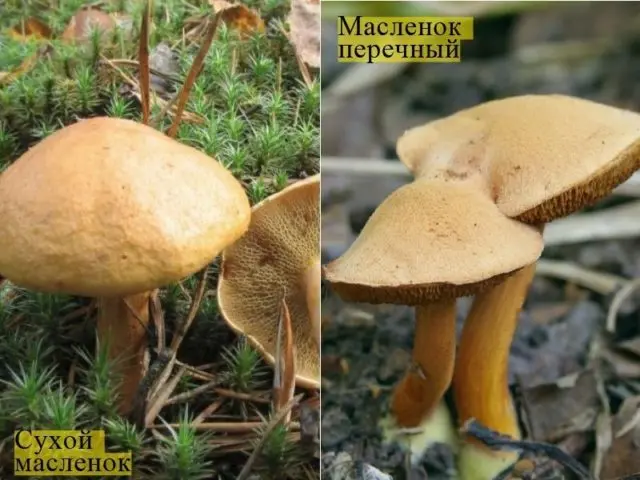
Peppers (pepper oil) can be found in the same places as kids. They share the same season. This name is given to these mushrooms because of the peppery taste of their pulp.
The pepper cap can be 2-8 cm in diameter, its shape is convex-rounded. The surface color varies from copper red to light brown or “rusty”. It is dry, slightly velvety, gleaming in the sun, but in rainy weather it becomes slimy, like a goat. The pulp is sulfur-yellow, friable, easily broken. The leg is 3-8 cm long, smooth, colored to match the hat, has a cylindrical shape, can be bent.
There is information that this mushroom is conditionally edible, it is mentioned as a snack for vodka, and there is also a spicy seasoning made from pepper, which was boiled for a long time. There is an opinion that the pulp of the pepper plant is toxic due to the fact that it contains rare chemical compounds that are not destroyed during heat treatment and provoke cancer, as well as cirrhosis of the liver. But most sources still agree that it is inedible, although not poisonous: it is undesirable to collect it, however, if it accidentally ends up in a saucepan along with goats, it will not spoil the dish.
The main differences between a dry butter dish and a pepper pot:
Sign | Dry butterflies (kids) | Peppers |
Leg color | Yellowish, beige, brown | To match the hat, always yellow at the base |
Cap flesh color | Pinkish, cream | Yellowish |
pulp taste | Soft | Sharp, sharp |
Tubular layer color | Yellow, olive brown, grayish | The same color as the hat, when pressed it becomes red-brown |
How they grow | More often in large groups | Infrequently and little by little |
Edible goat mushroom or not
Goats are edible mushrooms, however, unlike common butterflies, they do not have an expressive taste and aroma. At the same time, their chemical composition is quite rich (amino acids, sugars, carotene, phosphorus, magnesium, zinc, vitamins A, B, D, PP), and they are easily absorbed by the human body. It is even believed that dry butternuts have medicinal properties, since their pulp contains an antimicrobial substance – nebularin.
What is the difference between butterflies and goats
Common butterflies and goatlings are mushrooms that are quite easy to confuse. Both types are safe to eat. However, the taste and aroma of dry oil is noticeably poorer than that of ordinary ones.
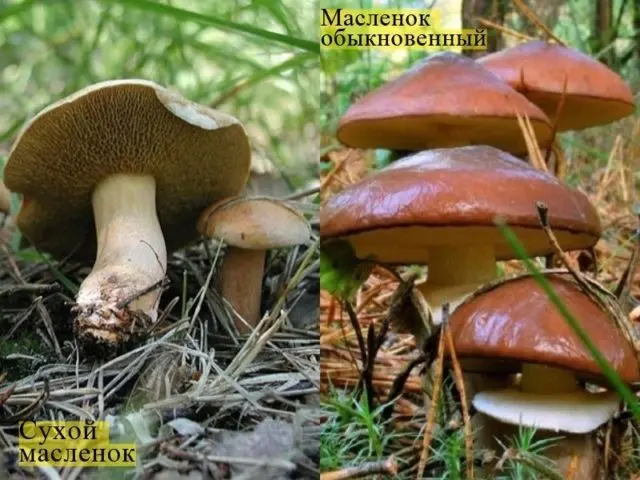
Characteristic signs of goat and oil mushrooms, in which their difference from each other is manifested:
Sign | Dry butterflies (kids) | Butterflies are ordinary |
Ring (“skirt”) around the leg | No | There is |
hat shape | In young mushrooms – neat, convex, resembles a pillow; in old ones – it becomes flatter and cracks | In young mushrooms – closer to the shape of a hemisphere; in the old it changes to a more prostrate one. The surface is solid throughout the entire life cycle |
Cap color | Tan, ocher, beige | Yellow-brown, chocolate brown, gray-olive |
The pores of the tubular layer | Large, irregular shape | small, rounded |
How to remove the skin from the hat | With difficulties | Relatively easy |
Where, when and how to collect goats
The goat gathering season can last from July to October, depending on the climate and weather conditions. Its peak, as a rule, falls on the end of July or August. Most often, dry butterflies grow in groups, but they are also found singly. The best harvest can be harvested after heavy rain.
It is recommended to cut young mushrooms, strong and whole in appearance, for example – a dry oiler in the photo:
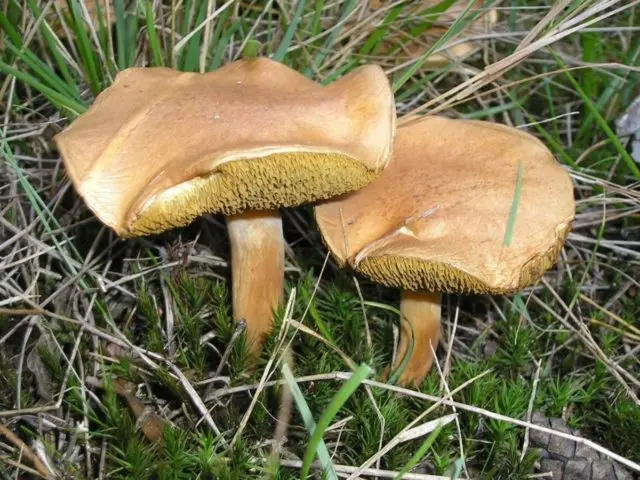
In addition, kids are very often affected by worms without visible damage from the outside. To check if the dry butter dish is wormy, at the collection stage, the hat must be cut.
How to cook goat mushrooms
Dry butter mushrooms are universal mushrooms. They are fried, boiled, stewed, pickled, dried and frozen. First and second courses are prepared from goats, they make seasonings, stuffing for pies, preparations for the future, and even jam is made in syrup from fruit juice.
Before any kind of cooking, dry butternuts should be prepared: cleaned of dirt, cut off the tip of the leg, spoiled or wormy places, rinsed in cold water, and then soaked in warm water for 15-20 minutes. In most cases, they are pre-boiled and then the first broth is completely drained.
The following photos and descriptions of dishes that can be prepared from goat mushrooms will help you figure out how best to dispose of the collected “booty”.
How to salt goats
For salting dry oil, young mushrooms with the strongest, most beautiful hats should be selected.
The process of preparing salted goats is simple:
- it is necessary to rinse the dry oils, clean them of debris and dirt;
- pour mushrooms into boiling water, add 1 tsp. salt and cook for 20 minutes over low heat;
- drain the broth;
- Rinse the kids under running clean water, put them in a colander and let them drain;
- put the mushrooms in a prepared container for salting, sprinkling with salt (60 g per 1 kg of kids);
- add spices to taste (chopped garlic cloves, horseradish root, tarragon, dill);
- put a wooden circle on top and press down with oppression.
After 3 days, the load should be removed. You can taste goats salted according to this recipe in a week.

How to dry goat mushrooms
The easiest way to harvest dry butter for future use is drying.
Previously, garbage is selected from the mass of mushrooms – twigs, leaves, moss residues. It is not advised to wash the kids that are planned to be dried; instead, it is advisable to carefully brush them with a brush or dry cloth, cleaning the contaminated areas. The legs from the hats should be separated.
There are several ways to dry goats:
- Cut mushrooms into small pieces. String on a strong thread and hang in the sun.
- Cut goats into thin plates. Spread out in a single layer on a flat baking sheet or spacing and set outside in a sunny spot. Dry the mushrooms for 2-3 days, bring them into the room at night.
- The fastest option for drying goatlings: place sliced u80buXNUMXbmushrooms on a baking sheet and place in an oven heated to XNUMX ° C. The door should be slightly open. From time to time, mushrooms need to be checked and “stirred” – so that they dry evenly.
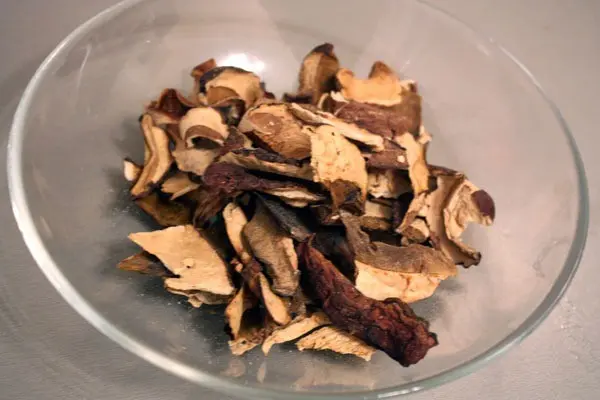
Goats fried with onions and sour cream
A simple and at the same time win-win option for a delicious second course of dry butter will turn out if you fry them with onions, adding sour cream.
So it is quite possible to cook goat mushrooms both on weekdays and for the holiday. The photo below shows the serving option:
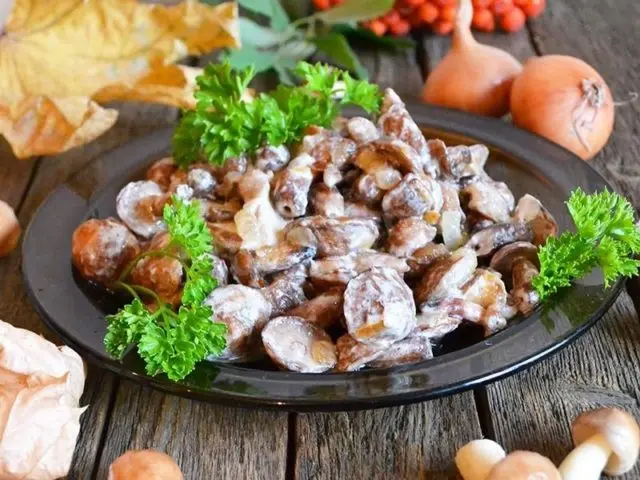
Preparation:
- cut the prepared kids into 3-4 pieces (small ones can be left whole) and boil for 20 minutes in salt water;
- drain the broth, throw the mushrooms into a colander;
- while dry butter is draining, cut into cubes a large onion and lightly fry in vegetable oil;
- put the mushrooms in the pan to the onion, mix and fry together for about 5 more minutes;
- add sour cream and finely chopped dill, salt;
- mix thoroughly and turn off the heat.
Serve fried dry butternuts hot, garnished with herbs.
Goat Salad with Pickled Onions
If you add boiled dry boletus with pickled onions, you get an interesting and savory appetizer that will undoubtedly succeed even on the festive table.
Preparation:
- kids, previously prepared, boil for half an hour in boiling salted water;
- fold in a colander, let the water drain, and the mushrooms – cool;
- at this time, peel and cut a large onion into half rings, add 2-3 tbsp. l. apple cider vinegar, salt, spices to taste;
- after 30 minutes, mix the prepared pickled onions with mushrooms, add a little vegetable oil;
- try and adjust if necessary.
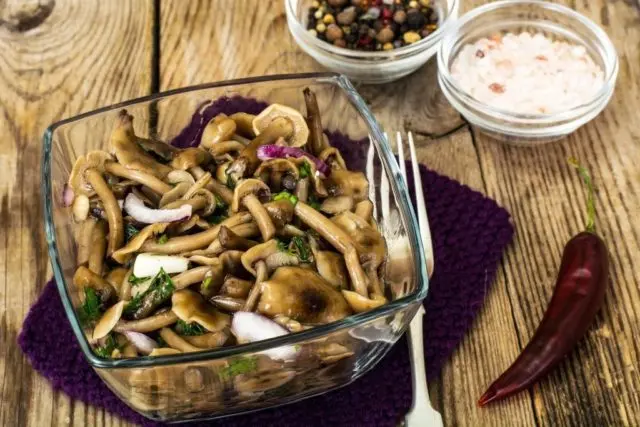
Conclusion
Despite the fact that goat mushrooms are inferior in taste and aroma to ordinary butterflies, they are very useful, widespread in forests and do not have false similarities. They are easy to assemble and clean, and pre-preparation before cooking requires minimal effort. In order to make a tasty and satisfying meal or preparation for the winter from dry butter, you just need to successfully decide on the recipe.









